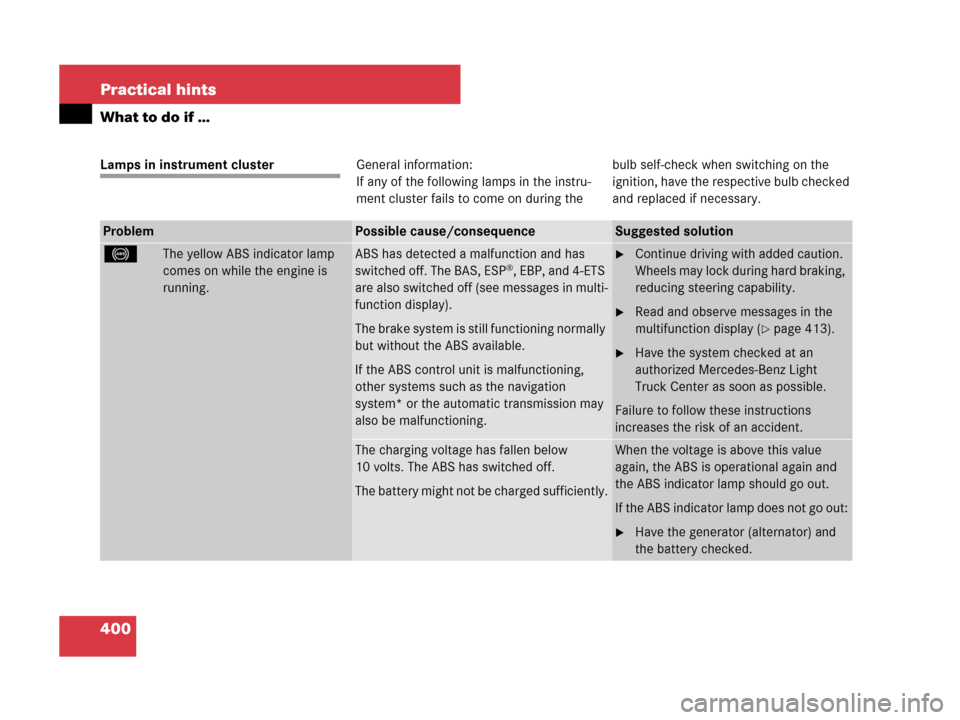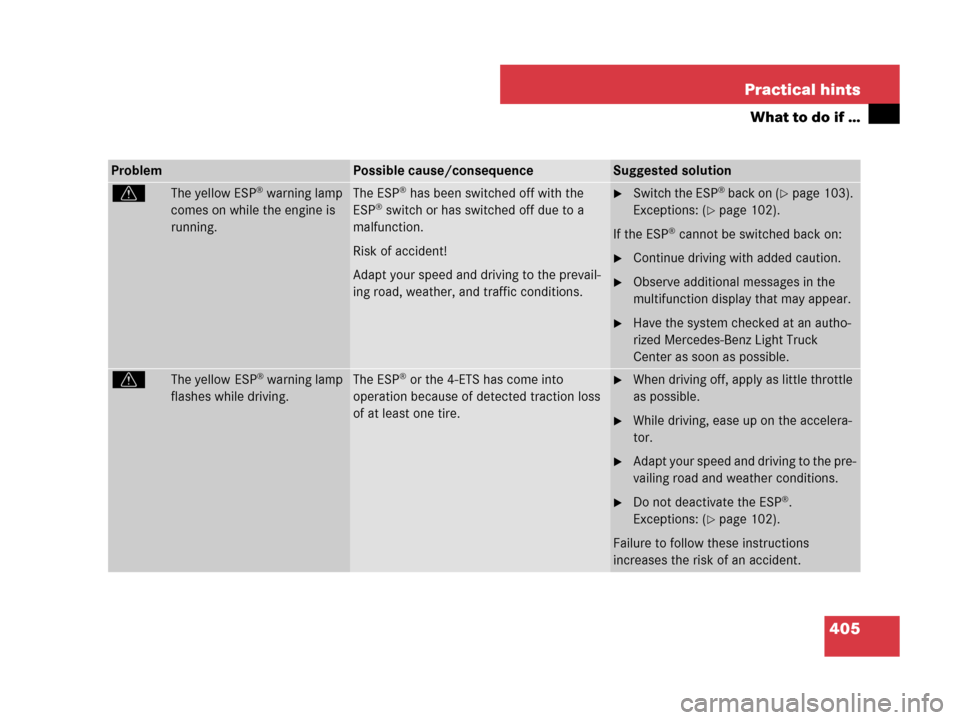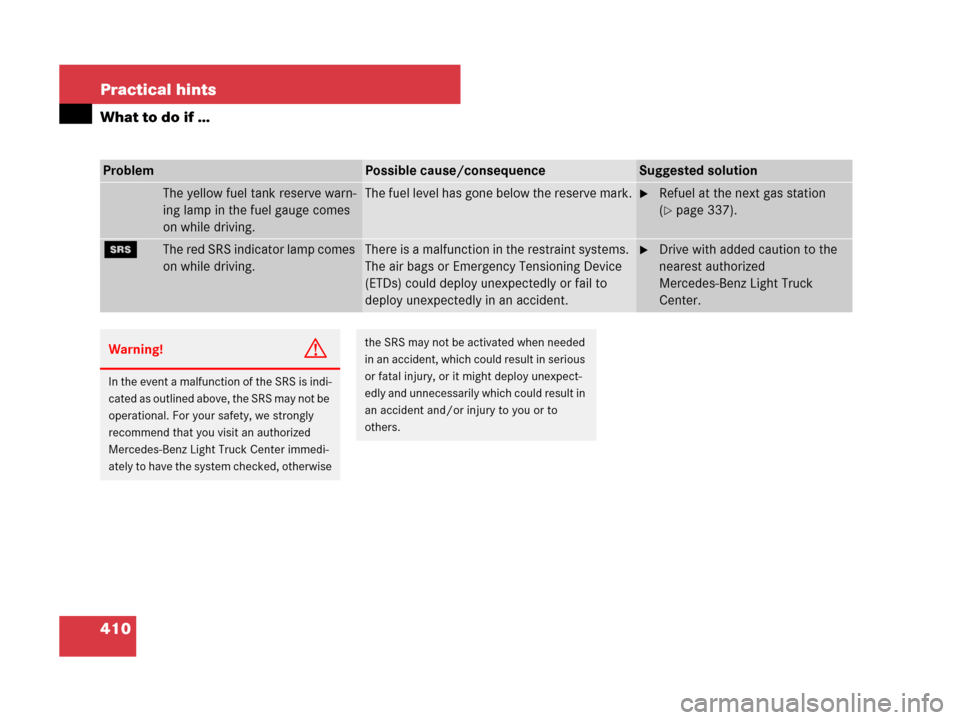Page 393 of 561

392 Operation
Vehicle care
Automatic car wash
You can have your car washed in an auto-
matic car wash from the start. Automatic
car washes without brushes are prefera-
ble.
�To protect the filter system, switch the
climate control system (
�page 206) or
the automatic climate control system*
(
�page 220) to air recirculation mode.
If the vehicle is very dirty, prewash it
before running it through the automatic
car wash.When taking the vehicle through an auto-
matic conveyor type car wash, observe the
following instructions.Vehicles with SmartKey:
�With the vehicle at a standstill and the
ignition switched on shift the automatic
transmission to neutral positionN.
�If engaged, release the parking brake
(
�page 57).
�Switch off the ignition and leave the
SmartKey in the starter switch.
Vehicles with KEYLESS-GO*:
�With the vehicle at a standstill, depress
the brake pedal and keep it pressed.
�With the ignition switched on shift the
automatic transmission to park
positionP.
�Release the brake pedal.
�Remove the KEYLESS-GO* start/stop
button from the starter switch
(
�page 41).
�Insert the SmartKey with
KEYLESS-GO* into the starter switch.
�Switch on the ignition.
�Depress the brake pedal.
!Do not clean your vehicle in an automatic
touchless car wash which use caustic spray.
Otherwise the caustic spray will damage the
paint or ornamental moldings.
!Make sure that the windshield wiper switch
is set to0 (
�page 61). Otherwise, e.g. the rain
sensor could activate and cause the wipers to
move unintentionally. This may lead to vehicle
damage.
Due to the width of the vehicle, fold in exterior
rear view mirrors prior to running the vehicle
through an automatic car wash to prevent
damage to the mirrors.
Warning!G
When leaving the SmartKey or SmartKey
with KEYLESS-GO* in the starter switch, do
not leave children unattended in the vehicle.
It is possible for children to switch on the
ignition which could result in unsupervised
use of vehicle equipment.
A child’s unsupervised access to a vehicle
could result in an accident and/or serious
personal injury.
Page 394 of 561

393 Operation
Vehicle care
�Shift the automatic transmission to
neutral positionN.
�Release the brake pedal.
�If engaged, release the parking brake
(
�page 57).
�Switch off the ignition and leave the
SmartKey with KEYLESS-GO* in the
starter switch.Ornamental moldings
For regular cleaning and care of ornamen-
tal moldings, use a damp cloth.Headlamps, brake lamps, tail lamps,
side markers, turn signal lenses
�Use a mild car wash detergent, such as
Mercedes-Benz approved Car Sham-
poo, with plenty of water.
iAfter running the vehicle through an auto-
matic car wash, wipe any wax off of the wind-
shield (
�page 395). This will prevent smears
and reduce wiping noise which can be caused by
residual wax on the windshield.
When leaving the car wash, make sure that the
mirrors are folded out. Otherwise they may
vibrate.
!Do not use chrome cleaner on ornamental
moldings. Although ornamental moldings may
have chrome appearance, they could be made of
anodized aluminum that will be damaged when
cleaned with chrome cleaner. Instead, use a
damp cloth to clean those ornamental moldings.
For very dirty ornamental moldings of which you
are sure are chrome-plated, use a chrome clean-
er. If in doubt whether an ornamental molding is
chrome-plated, contact an authorized
Mercedes-Benz Light Truck Center.
!Only use window cleaning solutions that are
suitable for plastic lamp lenses. Window clean-
ing solutions which are not suitable may damage
the plastic lamp lenses of the headlamps. There-
fore, do not use abrasives, solvents or cleaners
that contain solvents.
Never apply strong force and only use a soft,
non-scratching cloth when cleaning the lenses.
Do not attempt to wipe dirty lenses with a dry
cloth or sponge.
Otherwise you may scratch or damage the lens
surface.
Page 401 of 561

400 Practical hints
What to do if …
Lamps in instrument clusterGeneral information:
If any of the following lamps in the instru-
ment cluster fails to come on during thebulb self-check when switching on the
ignition, have the respective bulb checked
and replaced if necessary.
ProblemPossible cause/consequenceSuggested solution
-The yellow ABS indicator lamp
comes on while the engine is
running.ABS has detected a malfunction and has
switched off. The BAS, ESP®, EBP, and 4-ETS
are also switched off (see messages in multi-
function display).
The brake system is still functioning normally
but without the ABS available.
If the ABS control unit is malfunctioning,
other systems such as the navigation
system* or the automatic transmission may
also be malfunctioning.
�Continue driving with added caution.
Wheels may lock during hard braking,
reducing steering capability.
�Read and observe messages in the
multifunction display (
�page 413).
�Have the system checked at an
authorized Mercedes-Benz Light
Truck Center as soon as possible.
Failure to follow these instructions
increases the risk of an accident.
The charging voltage has fallen below
10 volts. The ABS has switched off.
The battery might not be charged sufficiently.When the voltage is above this value
again, the ABS is operational again and
the ABS indicator lamp should go out.
If the ABS indicator lamp does not go out:
�Have the generator (alternator) and
the battery checked.
Page 402 of 561

401 Practical hints
What to do if …
ProblemPossible cause/conse-
quenceSuggested solution
-The yellow ABS indicator lamp comes on while
the engine is running.The self-diagnosis has not yet
been completed yet.The display will clear after driving a short
distance at a vehicle speed of above
12 mph (20 km/h).
;(USA only)
3(Canada only)
The red brake warning lamp
comes on while driving and an
acoustic warning sounds.You are driving with the
parking brake set.�Release the parking brake
(
�page 57).
There is insufficient brake fluid
in the reservoir.�Risk of accident! Carefully stop the
vehicle in a safe location or as soon as
it is safe to do so.
�Apply the parking brake (�page 65).
�Contact an authorized
Mercedes-Benz Light Truck Center.
Do not add brake fluid! This will not
solve the problem.
Warning!G
Driving with the brake warning lamp illumi-
nated can result in an accident. Have your
brake system checked immediately if the
brake warning lamp stays on.
Do not add brake fluid before checking the
brake system. Overfilling the brake fluid res-
ervoir can result in spilling brake fluid on hot
engine parts and the brake fluid catching
fire. You can be seriously burned.!If you find that the brake fluid in the brake
fluid reservoir has fallen to the minimum mark or
below, have the brake system checked for brake
pad thickness and leaks.
Page 405 of 561
404 Practical hints
What to do if …
ProblemPossible cause/conse-
quenceSuggested solution
?(USA only)
±(Canada only)
The yellow engine malfunction
indicator lamp comes on while
driving.A loss of pressure has been
detected in the fuel system.
The fuel cap may not be closed
properly or the fuel system
may be leaky.�Check the fuel cap (�page 337).
If it is not closed properly:
�Close the fuel cap.
If it is closed properly:
�Have the fuel system checked by an
authorized Mercedes-Benz Light Truck
Center.
Vehicles with diesel engine:
Your fuel tank is empty.�After refueling start, turn off and
restart the engine three or four times in
succession.
The limp-home mode is canceled. You do
not need to have your vehicle checked.
Page 406 of 561

405 Practical hints
What to do if …
ProblemPossible cause/consequenceSuggested solution
vThe yellow ESP® warning lamp
comes on while the engine is
running.The ESP® has been switched off with the
ESP® switch or has switched off due to a
malfunction.
Risk of accident!
Adapt your speed and driving to the prevail-
ing road, weather, and traffic conditions.
�Switch the ESP® back on (�page 103).
Exceptions: (
�page 102).
If the ESP
® cannot be switched back on:
�Continue driving with added caution.
�Observe additional messages in the
multifunction display that may appear.
�Have the system checked at an autho-
rized Mercedes-Benz Light Truck
Center as soon as possible.
vThe yellow ESP® warning lamp
flashes while driving.The ESP® or the 4-ETS has come into
operation because of detected traction loss
of at least one tire.�When driving off, apply as little throttle
as possible.
�While driving, ease up on the accelera-
tor.
�Adapt your speed and driving to the pre-
vailing road and weather conditions.
�Do not deactivate the ESP®.
Exceptions: (
�page 102).
Failure to follow these instructions
increases the risk of an accident.
Page 411 of 561

410 Practical hints
What to do if …
ProblemPossible cause/consequenceSuggested solution
The yellow fuel tank reserve warn-
ing lamp in the fuel gauge comes
on while driving.The fuel level has gone below the reserve mark.�Refuel at the next gas station
(
�page 337).
1The red SRS indicator lamp comes
on while driving.There is a malfunction in the restraint systems.
The air bags or Emergency Tensioning Device
(ETDs) could deploy unexpectedly or fail to
deploy unexpectedly in an accident.�Drive with added caution to the
nearest authorized
Mercedes-Benz Light Truck
Center.
Warning!G
In the event a malfunction of the SRS is indi-
cated as outlined above, the SRS may not be
operational. For your safety, we strongly
recommend that you visit an authorized
Mercedes-Benz Light Truck Center immedi-
ately to have the system checked, otherwise
the SRS may not be activated when needed
in an accident, which could result in serious
or fatal injury, or it might deploy unexpect-
edly and unnecessarily which could result in
an accident and/or injury to you or to
others.
Page 412 of 561
411 Practical hints
What to do if …
Lamp in center console
ProblemPossible cause/consequenceSuggested solution
59The front passenger
front air bag off indica-
tor lamp illuminates
and remains illuminat-
ed with the weight of a
typical adult or some-
one larger than a small
individual on the front
passenger seat.The system is malfunctioning.�Have the system checked as soon as
possible by an authorized
Mercedes-Benz Light Truck Center.
�Also read and observe any messages
in the multifunction display and follow
corrective steps (
�page 421).
Warning!G
If the59indicator lamp
illuminates and remains illuminated with the
weight of a typical adult or someone larger
than a small individual on the front passen-
ger seat, do not have any passenger use the
front passenger seat until the system has
been repaired.